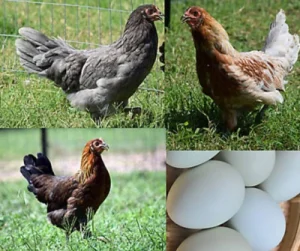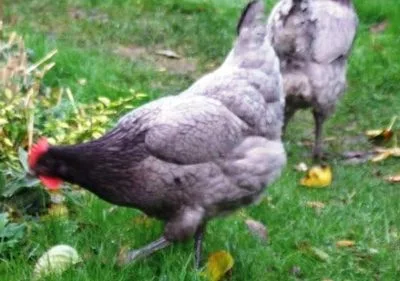No products in the cart.
Chicken
Prairie Bluebell Egger: Everything you need to know
Prairie Bluebell Eggers are among a few new chicken breeds that have gained popularity because of their ability to lay blue-shell eggs.
But that is not the only intriguing fact about the Prairie Bluebell Egger. Keep reading to find out even more fascinating things about this unique chicken breed.
*This post may have affiliate links, which means I may receive commissions if you choose to purchase through links I provide (at no extra cost to you). As an Amazon Associate I earn from qualifying purchases. Please read my disclaimer for additional details.
What Is A Prairie Bluebell Egger Chicken?
The Prairie Bluebell Egger is an active hybrid breed between the Araucana and the White Leghorn chicken breeds.
The White Leghorns were chosen due to their being prolific egg layers.
And the Araucana was chosen for its blue egg genes because they are amongst the most common breeds that produce blue eggs.
The result is an easygoing, active bird that forages for its own food and produces higher-quality eggs that happen to have blue shells.
Besides laying novel blue eggs, this hybrid breed comes with quite a few different plumages, all with beautiful color patterns.
There are many pictures of them taken by farmers online that prove that plumage color varies considerably.
So, you can expect to have some prairie bluebells on your farm that do not look like each other at all!
Another interesting fact is that the ear lobe color of prairie bluebell hens is the same as the egg color. You may use this fact to tell which one in your flock is the Prairie Bluebell Egger.
Usages
Inheriting the gene for the ability to lay a large quantity of eggs from the White Leghorns, the Prairie Bluebell Egger is therefore mainly raised for egg production.
Read More: Why Do Chickens Lay Eggs Without Fertilization? We share common reasons why and how to prevent unfertilized eggs if you’re looking to grow your flock!
Hen vs Rooster

The Prairie Bluebell Egger is not as big and heavy as other breeds, with a mature hen weighing about 4lbs while a male one weighs 5lbs.
In terms of appearance, a young male chick will have shorter pin feathers compared to those of a female.
However, early feather sexing for hybrid breeds is not always accurate because inconsistent breeding leads to inconsistent appearance.
That is why experienced farmers usually wait until the chicken is at least 12 to 16 weeks old to confirm the gender.
At that point, a cockerel will have his typical saddle feathers, which separate him from other pullets.
Eggs
At 5 months of age, the hen will be of laying age and ready to lay eggs.
Their pretty light blue eggs are in medium size weighing around 53-63 grams, including the shell.
But compared to other Blue Eggers like the Whiting True Blue or the Speckled Seafoam, the Prairie Bluebell Egger eggs are slightly bigger.
Each year, a hen can lay approximately 280 eggs, but the first 1 to 2 eggs may not be as blue as you expected.
Don’t worry, as the Prairie Bluebell Egger matures, so too will the blue color and soon you will find a sweet surprise in your backyard.
Read our related article, How Big is a Duck Egg Compared to a Chicken Egg? We compare chicken and duck eggs in this exhaustive guide!
Temperament & Health
Prairie Bluebell Eggers are known to be great foragers who actively look for food around on their own.
They are also easygoing and easy to be kept in confinement. People also choose this breed because of its healthy adaptation to all different climates and because it can be a kid-friendly breed.
Price
Generally, this breed is a bit more expensive than other breeds like Easter Egger or Olive Egger.
A Prairie Bluebell Egger chick costs around 4 to 5 dollars ($USD), and an extra 2 dollars ($USD) approximately for a female one.
Sellers like Hoover’s Hatchery often offer a minimum quantity of 5 chicks for each sex.
The bigger the purchase, the more economical the purchase.
Also, it is important to check with the breeder whether or not the chicks are vaccinated, right from your purchase. If they are not, you will want to feed them medicine to prevent diseases like Coccidiosis.
Did you know:Can Chickens eat Popcorn?
Tips On Caring For Baby Chicks
To ensure the healthy development of your newborn Prairie Bluebell chicks, there are a few things you should pay attention to.
1. Keep Them Warm
Keeping baby chickens warm during the first few weeks is not only important to their health but also vital.
Using a red bulb is a great place to start and the brooder area needs to be maintained at 95-100 degrees for 2 weeks after the egg hatches.
Then, for the next 2 weeks, the temperature in the brooder area can be lowered by 5 degrees each week.
It is also crucial to leave enough space inside for the chicks to move around themselves, allowing them to find the best suitable place for their body temperature.
2. Food & Water
We advise you to use non-dripping feeding equipment to keep the feeding area dry and clean.
A chick fountain is an excellent choice for water supply.
For food, during the first 8-10 weeks, you can feed them with a chick starter mix of 20% protein.
After that, they are ready to take 18-19% of young chicken growers.
3. Safe Bedding
Proper bedding is a crucial factor in the development of the chicken’s feet.
The best way is to line the box with a few newspaper sheets at the bottom and 2-3 inches of pine shavings, chopped straw, oat hulls, or ground cobs on top.
Once the bedding is dirty, you can just roll up the paper and discharge it.
Read More: Chicken Egg vs Duck Egg Taste. We explore the differences between duck eggs and chicken eggs and compare their taste, size, and uses!
Expect Real Blue Chicken Eggs
When thinking about eggs, many people only believe there are two egg colors, white and brown, and that the colorful easter eggs are hand-painted.
Well, yes they are, but there are also a few “odd” shades of eggs aside from the traditional colors like blue and even green.
From the article above, your mind might have been blown away knowing that there are some breeds of chicken that can lay pure blue eggs.
And the Prairie Bluebell Egger chickens, which are easy-going, hardy, great blue egglayers, are a great breed to be kept in your backyard.
We hope the information has helped you get ready to welcome a Prairie Bluebell Chick on your farm because it will be worth it!
Read More: How Many Chickens Should I Get for Eggs? Here’s a chart to help you find the right number of chickens for the eggs you use!
FAQs
1. How long do Bluebell chickens live?
Bluebell chickens can have up to 8 to 10 years of age, with the average being 5 years.
2. What time of day do chickens lay eggs?
Chickens lay eggs in the morning, usually within 6 hours of sunrise. Egg-producing cycles take about 26 hours so you will not find eggs at the same exact time every day.
3. How do I encourage my chickens to lay eggs?
There is no magic pill and no way to force your chickens to lay eggs. But, you can encourage them with special treats like mealworms, greens, watermelon, and even sunflower seeds.
You can also extend the hours that your chickens are exposed to light for no more than 16 hours.
4. What chicken breed lays purple eggs?
There are no chickens that lay purple eggs. If you find a purple egg, you are looking at its protective layer referred to as “the bloom” which keeps the egg fresh and free of bacteria.
5. Are blue eggs healthier?
While blue eggs are cool, they are not actually healthier. In fact, no matter what the color is of the egg shell, there are no nutritional differences.


I think the following is a typo, 3rd paragraph under Hens vs Roosters. I’m sure you mean 12-16 WEEKS, not MONTHS, confirmed by a later statement that hens can start laying at 5 months.
“That’s why experienced farmers usually wait until the chicken is at least 12 to 16 months old to confirm the gender.”
Thanks for letting me know. That’s my mistake. “Weeks”, not “months”.